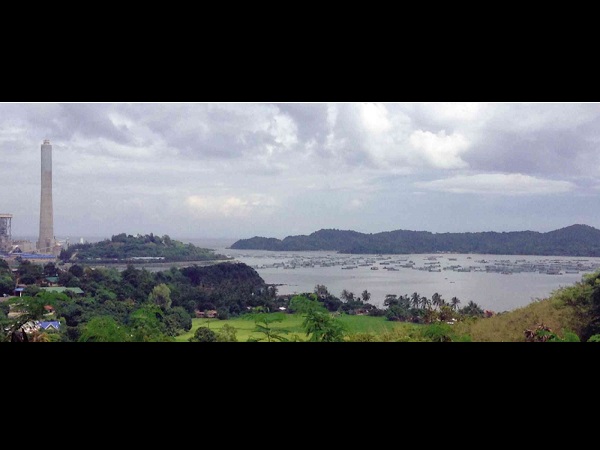
HUNDREDS of fish cages crowd Cabalitian Bay in Sual town, many of them built near the periphery of the coal-fired power plant. GABRIEL CARDINOZA/INQUIRER NORTHERN LUZON
SUAL, Pangasinan—While he saw the fish cage operations in this town’s sea space as posing no threat to the 1,200-megawatt Sual power plant, Mayor Roberto Arcinue said the town would heed the proposal to withdraw them from the plant’s perimeters.
Arcinue admitted that some cages are near the plant. “[But] how could aquaculture businessmen and their workers pose a threat to the supposedly highly secured plant? From its start of operations, there has never been a report to the police about threats to the security of the plant,” Arcinue said.
Ruben Licerio, vice president for operations of Team Energy, which owns and operates the plant, earlier wrote Arcinue about moving the fish cages farther away from the plant, saying these imperiled its operations.
Arcinue said he had not replied to Licerio’s letter because the local government decided to first conduct an inventory of the cages.
“It is true that the cages have come near the plant’s perimeter. Also, some legitimate cage operators [have been] practicing a ‘kabit’ system, [which means some licensed operators] allow others to put up cages near their structures [for a fee],” he said.
“We will have these infractions corrected,” he added.
Froilan Gregory Romualdez III, Team Energy’s head of external affairs, said the company was “working closely with Sual municipal officials to resolve this issue at the soonest possible time.”
“We share the opinion that at present, some of the fish cages are too close to the plant,” Romualdez said.
In a statement, he said: “The closest [cage] is around
110 meters away [from the perimeter]. From a security point of view, there is a need to maintain a standoff distance so that in extreme scenarios, we can effectively protect the plant from possible projectile explosives. The close proximity of the fish cages can likewise obstruct the view of our security team and the movement of our security patrol vessels, thus impeding our capacity to effectively secure the plant.”
Arcinue said he intended to place the cages 200 m away from the plant’s perimeter, but the local government would not want any of the licensed cages to be dismantled to heed Team Energy’s request.
“Sual has vast sea space and could accommodate more cages,” he said.
Records of the Bureau of Fisheries and Aquatic Resources (BFAR) show that the number of cages in the town has more than doubled, from 370 on the days leading to the May midterm elections to 778 after.
Nestor Domenden, BFAR Ilocos director, said he was surprised by the proliferation of the fish cages during the election period. “Sual was one of the more compliant local government units [to] BFAR’s recommended regulations,” he said.
He said Sual helps fulfill Luzon’s fish sufficiency, “but there should be balance between production and protection of the environment.”
Team Energy has expressed concern that extreme weather conditions usually lead to the destruction of fish cages. “This may cause large volumes of milkfish to be released into the bay and be sucked into the water intake, potentially disrupting operations. This is possible in an extreme case scenario,” Romualdez said.
But Arcinue said the aquaculture area is on Cabalitian Bay at the south end of the plant, while the plant’s water intake is located near Pao Bay, which is northeast of the plant. He said the cultured fish could not reach the intake.
“Besides, we know that the plant’s water intake is as thick as three layers of nets to prevent fish and other marine life from being sucked in,” he said.
Romualdez said the company’s primary interest is “to operate the plant in an efficient and reliable manner, allowing us to provide much needed power to the Luzon grid.” Yolanda Sotelo, Inquirer Northern Luzon